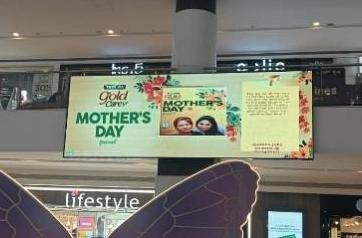Harnessing the Power of UGC and Programmatic DOOH
by Grace Dillon on 30th Jun 2023 in News

In association with Lemma Technologies
Merlin Coutinho, head of marketing, Lemma, discusses how brands are tapping into a growing trend of dynamic audience engagement and leveraging programmatic technology to amplify user-generated content (UGC) on digital out of home (DOOH).
In today's digital landscape, brands are constantly seeking innovative ways to captivate and engage their audiences. A growing trend that has emerged is the integration of programmatic technology and user-generated content (UGC) on digital out of home (DOOH) screens in real-time. At present, over 86% of marketers have incorporated UGC into their marketing strategy. The powerful combination of DOOH and UGC allows brands to tap into the dynamic nature of audience engagement and create impactful marketing campaigns.
User-generated content is a powerful marketing tool that can boost your brand – it's the content created by your customers based on their experiences and opinions. UGC generates 28% higher engagement compared to standard company posts, and 85% of consumers report that visual UGC has more of an impact on their buying decisions than brand photos and videos. Programmatic DOOH is the automated, addressable, and data-driven buying and selling of digital ads on place-based screens. By integrating UGC with programmatic DOOH, you can showcase real customer stories on large screens in shopping malls and stores. With the growing demand by the audience for faster and more personalised content which is accessible on the go, digital OOH advertising combined with UGC fits right in the picture: it perfectly satisfies these demands with greater effectiveness and efficiency.
Creating dynamic and engaging campaigns
The integration of programmatic technology and UGC on DOOH screens opens a world of possibilities for brands. Real-time updates and dynamic content changes allow brands to adapt their messaging on the fly, responding to current trends and events. This ensures that campaigns remain relevant and engaging, capturing the attention of viewers in public spaces where DOOH screens are prominently displayed.
Driving brand awareness and social interaction:
The combination of programmatic DOOH and UGC fosters social interaction and creates buzz around brands. Engaging and relatable UGC displayed on digital screens in public areas prompts viewers to share their experiences and opinions, further amplifying the reach and impact of the campaign. This user-driven approach to advertising enhances brand awareness, fosters brand loyalty, and encourages positive word-of-mouth.
Successful implementation of programmatic DOOH and UGC integration
One of the first DOOH campaigns to feature UGC was ‘Grateful Britain’. This involved social media posts thanking the heroes on the front line of the COVID-19 pandemic being displayed on large DOOH screens, where key workers would be able to read them.

Another notable example is the campaign by Tata Tea Care Gold in India, which invited customers to share photos of their mums ahead of Mother’s Day on social media and tag the brand. Selected photos were then featured in real time on digital billboards in shopping malls on Mother’s Day across major cities. This comprehensive social media campaign and an on-ground activation (in this case, a photo booth) generated excitement among users, fostering meaningful interactions and engagement with brands.

In a recent instance in Mumbai, the web series "Modern Love" by Prime Video showcased real-time tweets on DOOH screens throughout the city. These heartwarming love anecdotes generated a buzz on social media, capturing the attention of viewers and sparking engagement.
As brands continue to seek innovative ways to engage their audience, the integration of programmatic technology and user-generated content on digital OOH screens emerges as a powerful strategy. By leveraging real-time optimisation, the authenticity of UGC, and the dynamic nature of DOOH, brands can create compelling campaigns that capture attention, drive social interaction, and, ultimately, foster brand growth in today's evolving marketing landscape.








Follow ExchangeWire